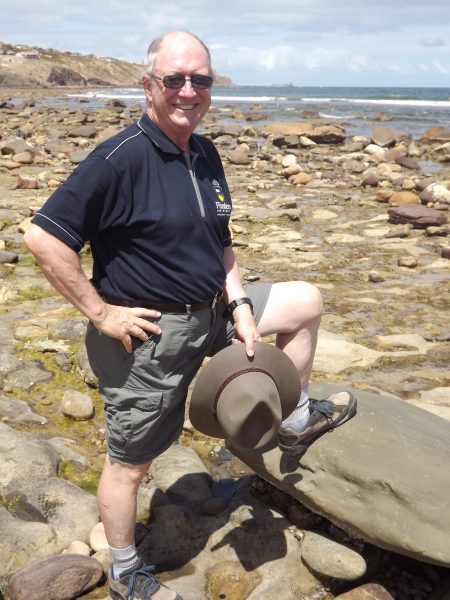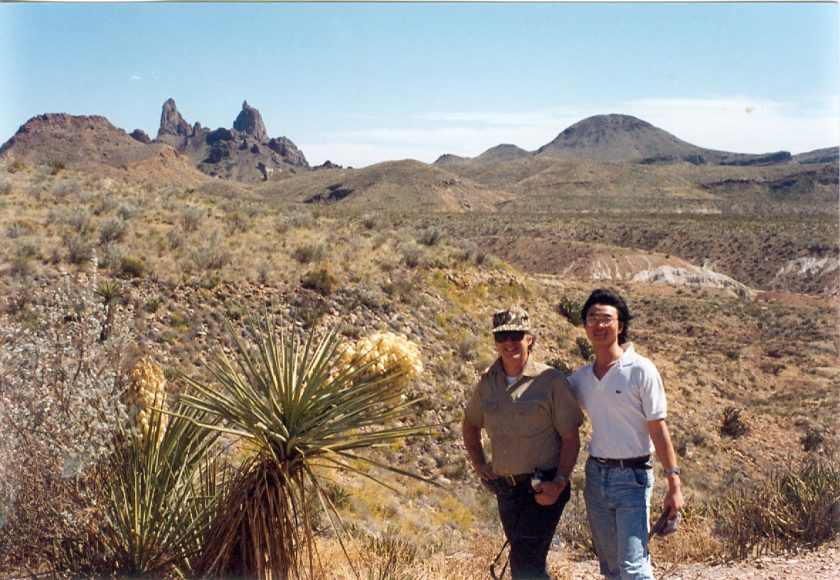Scientist Profile: Jack Sharp
November 20, 2017

by Barbra A. Rodriguez
Inquisitive researcher. Giving educator. Dedicated citizen. John M. (Jack) Sharp Jr. is known as a hydrogeologist who approaches his professional life at full throttle. As a testament to his active 43 years of professordom, the four-foot-wide set of Longhorns above his office desk is dwarfed by a sea of plaques around it — a reflection of a commitment to serving his profession that takes five pages to recap on his CV.
Sharp has also built a reputation during 35 years on campus as a scientist whose wide-ranging interests have extended from basic research on groundwater recharge to understanding the formation of deep sinkholes.
“There are some people who know exactly what they’re going to do as a career,” Sharp noted. “But mine … it’s just been an adventure.”
To analyze a Mexican sinkhole that is the Earth’s thirddeepest, he helped obtain funding from NASA to build a rover that plunged 300 meters into Cenote Zacatón.
He also is known for developing the first mathematical model of the effects of physical changes that occur on the surfaces of fractured rocks and of how layers of water with different densities can overturn of their own accord in sedimentary systems. As an offshoot of his analyses of natural springs in Central Texas, Washington D.C., and elsewhere, he uncovered the way waterborne contaminants use the sandy material that surrounds underground utility pipes as conduits for transport.
Sharp initially studied geological engineering at the University of Minnesota on the advice of that state’s Geological Survey director, a family friend. A sense of duty led him to Air Force officer training school instead of accepting Peace Corps or graduate school offers. While stationed in Wichita Falls, Texas, during the Vietnam War, he married his wife of 50 years, Carol, and began contemplating teaching.
The four-year break helped him refocus. He earned a doctorate in hydrogeology from the University of Illinois at Urbana–Champaign, studying the movement of heat through layers of sediment. The work earned Sharp the O.E. Meinzer Award — hydrogeology’s highest honor. Other awards have since followed from organizations large and small. In fall 1974, he first began sharing his love of learning on faculty at the University of Missouri–Columbia and came to The University of Texas at Austin in 1982. Over 100 graduate students and postdoctorates have benefited from his guidance.
Wendy Robertson, an assistant professor at Central Michigan University, completed her Ph.D. with Sharp at the Jackson School of Geosciences in 2014, and recalls his inspirational energy. She can still imitate his voice from when he awakened field camps at dawn with a song of reveille. His unguarded support for students’ projects she remembers especially, referring to it as being “like air underneath your wings.” For instance, he supported Robertson’s development of a side project that has led her to consult on water resources in Haiti and Africa.
“His cheerleading really did shape me as a scientist because it allowed me to step out on the edge and think about what’s practical,” she said. “I definitely credit the independence he instilled with my current success.”
“There are some people who know exactly what they’re going to do as a career. But mine … it’s just been an adventure.”
-Jack Sharp
Robertson also notes benefiting from the community of colleagues Sharp has made while collaborating on research and educational projects, and spearheading or contributing to professional meetings and endeavors. He has given keynote addresses in five countries, is a past president of the Geological Society of America, and a past president and treasurer for the U.S. chapter of the International Association of Hydrogeologists, among a multitude of
professional roles.

Sharp also helps citizens consider waterrelated challenges. Buried amidst mementos coating his office door is a bumper sticker with a quote from a character by author Robert Heinlein: “A generation, which ignores history, has no past and no future.” Sharp said that hydrogeologists are particularly poised to help explain resource challenges.
“We deal with the present, try to understand the past, and often project into the future with almost any water issue you look
at,” he said.
His focus on the impact of urbanization intensified after moving to Austin to join the geology faculty in 1982. Among the dozens of talks he has provided pro bono, for have been several for West Texas residents wondering how Balmorhea Springs could be affected by possible hydraulic fracturing for oil.
“It’s important to put out the current science as best as we understand it [to foster wise decision making],” Sharp noted. “Sometimes it’s not appreciated, but it’s something every scientist should do.”
As for retirement, he still has presentations and manuscripts such as a dense memoir about the Edwards Aquifer to help develop, and classes to teach. When he accepts full retirement and shorter office hours next summer, a hydrogeology glossary beckons, and a monthly newsletter must be kept alive.
“I’ll continue to learn — and hopefully contribute — to science,” Sharp said.
Back to the Newsletter